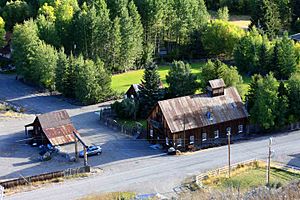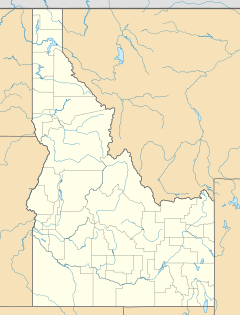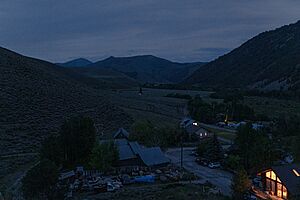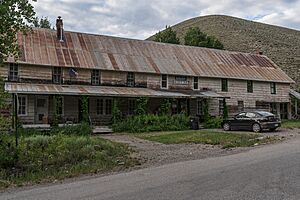Triumph, Idaho facts for kids
Quick facts for kids
Triumph, Idaho
|
|
|---|---|

Tucker's Barn in Triumph
|
|
| Country | United States |
| State | Idaho |
| County | Blaine |
| Elevation | 6,112 ft (1,863 m) |
| Time zone | UTC-7 (Mountain (MST)) |
| • Summer (DST) | UTC-6 (MDT) |
| ZIP codes |
83333
|
| Area code(s) | 208, 986 |
| GNIS feature ID | 398264 |
Triumph is a small place in Idaho, United States. It's called an unincorporated community. This means it's a group of homes and buildings that isn't officially a town or city with its own local government. Triumph is found in Blaine County, near the East Fork of the Big Wood River.
This community was once famous for the Triumph Mine. This mine produced a lot of silver and lead for many years. Today, fewer than 50 people live in Triumph full-time. It's about 12 miles north of a town called Hailey.
A fun fact about Triumph is that it was the childhood home of Picabo Street. She is a famous U.S. Olympic skier!
Contents
The Triumph Mine: A Look Back
The Triumph Mine first started when a claim called "North Star" was made in 1883. Over the next 20 years, many other claims were added. These claims were run by 14 different mining companies. All the valuable rock, called ore, was sent to a company in Ketchum for processing.
Early Mining Days
In 1889, the North Star mill was built by the Freedman's of The Philadelphia Company. A man named George Hurst bought them out around 1927. His company, San Louise Mining Company, took over. Sadly, a fire destroyed the mill in 1933. After that, the mined ore was just stored in piles.
World War II and Beyond
Around 1937, the U.S. government helped expand the Triumph Mine. This was because of World War II. They built a modern mill and new buildings. They also dug a main tunnel that went deep into the mountain.
The smaller companies joined together to form "The Triumph Mining Co." During World War II, this company was very busy. It employed about 200 men, working all day and night. At one point, the mine even held a world record for producing zinc!
By 1959, the prices for lead, silver, and zinc had dropped a lot. Also, workers were asking for higher pay. Because of these reasons, the mine closed down in 1959. It was then sold to the mine's foreman.
Later Efforts and Cleanup
In 1964, a new company called Triumph Mineral Company started up. They began mining again in 1970. Later, in 1982, another company leased the mine. They did a lot of drilling and explored the mine and the leftover piles of rock, called tailings. Records showed there was still a lot of gold in these tailings. However, gold was not considered a "strategic metal" by the government at the time.
In 1988, the EPA (a government group that protects the environment) said Triumph might be a danger. Over the next 10 years, they spent millions of dollars cleaning up the area. Instead of getting the gold from the tailings to help pay for the cleanup, the EPA and the state decided to bury it.
In 2007, Carl Massaro bought the Triumph Mine. He wanted to build a small "solar village" there. He also planned a large solar collector. This idea was part of a new EPA program to clean up old mine sites. However, people didn't like the idea, and the project didn't happen. The mountain was sold in 2008. But the Triumph Mineral Company still owns the tailings. They still hope to start a solar project there in the future. The new owners have cleaned the site more. Even though there are still valuable resources in the mine, the state and local leaders have agreed that mining will not happen there again.





